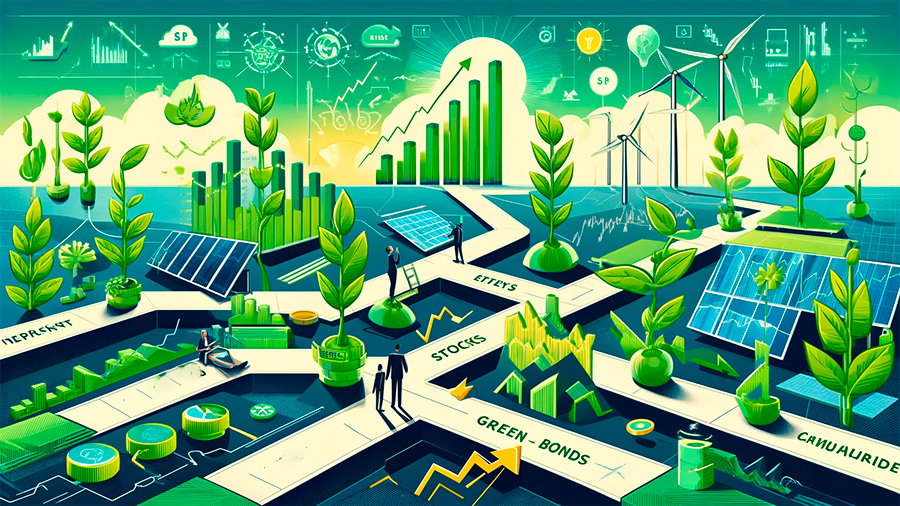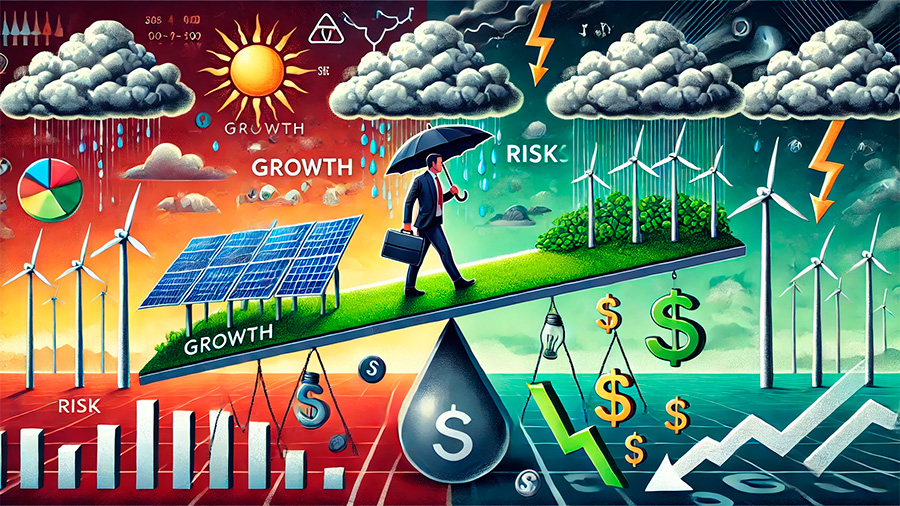Why Renewable Energy is the Future of Investment: Strategies for Long-Term Gains
The renewable energy sector is rapidly expanding as the world transitions toward cleaner, more sustainable energy sources. As global concerns over climate change intensify, governments, businesses, and consumers are increasingly shifting focus from traditional fossil fuels to renewable energy, making it one of the most promising areas for long-term investment. Whether it’s solar, wind, hydropower, or newer technologies like hydrogen fuel cells, the renewable energy sector offers substantial growth potential.
For investors, renewable energy presents not only an opportunity to support a more sustainable future but also a way to capitalize on the sector’s accelerating growth. The combination of technological advancements, government incentives, and increasing demand for clean energy has positioned renewables as a key investment area for the next decade and beyond.
In this article, we’ll explore how to invest in renewable energy, why it’s a smart move for future growth, and practical strategies for building a renewable energy-focused investment portfolio.
The Growth of Renewable Energy: Why It’s the Future
Renewable energy is no longer a niche market. In recent years, it has become a mainstream investment sector as more countries commit to reducing carbon emissions and increasing the share of renewables in their energy mix. The global renewable energy market is expected to grow at a significant rate, driven by several key factors.
1. Government Support and Policies
Governments around the world are setting ambitious targets for reducing greenhouse gas emissions, and many are offering financial incentives to promote the use of renewable energy. From tax credits to subsidies, these policies are accelerating the development and deployment of renewable energy projects.
- Government initiatives: In the U.S., the federal government offers tax credits for investments in solar energy and other renewables, while the European Union has committed to becoming climate-neutral by 2050. These and other initiatives encourage investment in the sector by reducing the financial barriers to entry.
- Global agreements: International agreements like the Paris Climate Accord further reinforce the global commitment to reducing emissions and increasing renewable energy use, creating long-term demand for renewable energy projects.
Government support and regulatory policies are key drivers of growth in renewable energy, providing investors with a favorable environment for long-term gains.
2. Technological Advancements
Technological advancements are making renewable energy more efficient and cost-effective. Innovations in solar panels, wind turbines, energy storage, and grid integration are driving down the costs of renewable energy production, making it competitive with—and in some cases cheaper than—fossil fuels.
- Solar energy costs: The cost of solar energy has dropped by nearly 90% over the past decade due to improvements in panel efficiency and manufacturing processes. As technology continues to advance, solar energy will become even more affordable and accessible.
- Energy storage: Battery technology is improving, allowing renewable energy to be stored and used even when the sun isn’t shining or the wind isn’t blowing. This solves one of the key challenges of renewable energy and increases its reliability as a primary energy source.
As technology advances, the renewable energy sector will continue to grow, offering investors the opportunity to benefit from new innovations and improvements in efficiency.
3. Rising Demand for Clean Energy
Consumers and businesses are increasingly prioritizing clean energy sources due to growing environmental awareness and the desire to reduce reliance on fossil fuels. As demand for renewable energy grows, so too does the need for new projects and infrastructure to support that demand.
- Corporate commitments: Many large corporations, such as Google, Apple, and Amazon, have pledged to use 100% renewable energy in their operations. These commitments are driving significant investment in renewable energy infrastructure and creating long-term demand.
- Consumer preferences: Consumers are becoming more environmentally conscious, and many are willing to pay a premium for clean energy. This shift in consumer behavior is pushing utility companies and governments to accelerate their renewable energy offerings.
The increasing demand for renewable energy from both consumers and businesses ensures that the sector will continue to expand, creating opportunities for investors to benefit from long-term growth.

How to Invest in Renewable Energy
There are several ways to invest in renewable energy, ranging from individual stocks to more diversified approaches like exchange-traded funds (ETFs) and green bonds. Here are the key strategies for building a renewable energy-focused investment portfolio.
1. Invest in Renewable Energy Stocks
One of the most direct ways to invest in renewable energy is by purchasing stocks of companies that produce or support renewable energy. These can include companies involved in solar, wind, hydropower, energy storage, and other renewable energy technologies.
- Solar energy stocks: Companies like First Solar and SunPower are leaders in solar energy production and technology. These stocks allow investors to gain exposure to the rapidly growing solar industry, which is expected to play a critical role in the global energy transition.
- Wind energy stocks: Wind energy companies such as Vestas Wind Systems and Siemens Gamesa are major players in the wind power market. Investing in these stocks gives investors access to one of the fastest-growing segments of the renewable energy industry.
- Energy storage and infrastructure: Companies that provide energy storage solutions, such as Tesla, and those involved in building renewable energy infrastructure, such as NextEra Energy, also offer attractive investment opportunities in the renewable energy space.
Investing in individual renewable energy stocks allows you to target specific companies and technologies, providing potential for high returns as the sector grows.
2. Invest in Renewable Energy ETFs
If you prefer a more diversified approach, investing in exchange-traded funds (ETFs) focused on renewable energy is a great option. ETFs provide exposure to a broad range of companies in the renewable energy sector, reducing the risk associated with investing in individual stocks.
- Popular renewable energy ETFs: ETFs such as the iShares Global Clean Energy ETF and the Invesco Solar ETF provide exposure to a wide variety of renewable energy companies, including solar, wind, and energy storage firms. These funds spread your investment across multiple companies, offering diversification and reducing the impact of any one company’s performance.
- Broader clean energy exposure: Some ETFs focus on broader clean energy sectors, including renewable energy and other environmentally friendly technologies. These funds may include investments in electric vehicles, smart grids, and energy efficiency technologies, providing even greater diversification.
ETFs are an ideal choice for investors who want to invest in renewable energy without the risk of picking individual stocks. They offer diversification, liquidity, and the potential for long-term growth as the sector expands.
3. Consider Green Bonds
Green bonds are fixed-income securities that are used to fund projects related to environmental sustainability, including renewable energy projects. By investing in green bonds, you can earn interest while supporting the development of clean energy infrastructure.
- Stable income: Green bonds offer a stable income stream, making them an attractive option for more conservative investors who want exposure to renewable energy without the volatility of stocks.
- Government and corporate green bonds: Both governments and corporations issue green bonds to finance renewable energy initiatives. For example, the European Union and companies like Apple have issued green bonds to fund solar, wind, and other renewable energy projects.
Green bonds provide a low-risk way to invest in renewable energy, offering predictable returns while contributing to the growth of the clean energy sector.
4. Invest in Renewable Energy Mutual Funds
Mutual funds that focus on renewable energy offer another diversified investment option. These funds pool money from multiple investors to invest in a variety of renewable energy stocks, bonds, and other assets.
- Managed portfolios: Unlike ETFs, mutual funds are actively managed by professional portfolio managers, who make decisions about which renewable energy companies to invest in. This allows for more targeted investment strategies based on the fund manager’s expertise.
- Sustainability-focused mutual funds: Some mutual funds focus specifically on sustainable or environmentally responsible investments, including renewable energy companies. These funds align with the growing demand for socially responsible investing and provide exposure to clean energy while promoting broader environmental goals.
Mutual funds are an excellent choice for investors who prefer a professionally managed, hands-off approach to investing in renewable energy.

Risks and Considerations When Investing in Renewable Energy
While renewable energy presents significant growth opportunities, it’s important to understand the risks associated with investing in the sector. Here are some key considerations to keep in mind.
1. Market Volatility
Like any sector, renewable energy stocks can be volatile, especially as they are influenced by government policies, technological advancements, and shifts in consumer demand. While the long-term outlook for renewable energy is positive, short-term market fluctuations can impact stock prices.
- Policy changes: Government policies play a significant role in the growth of renewable energy. Changes in tax incentives or regulations could affect the profitability of renewable energy projects, leading to fluctuations in stock prices.
- Technological disruption: While technological advancements are driving down the costs of renewable energy, the sector is highly competitive. New innovations could disrupt existing companies, leading to volatility in the market.
Investors should be prepared for some level of volatility and focus on long-term growth rather than short-term gains when investing in renewable energy.
2. Capital Intensity
Renewable energy projects often require significant capital investment, which can impact the financial performance of companies in the sector. Solar and wind projects, in particular, involve high upfront costs for equipment and infrastructure.
- High capital expenditures: The capital-intensive nature of renewable energy projects means that companies may need to raise funds through debt or equity offerings, which can dilute existing shareholders or impact profitability.
- Long payback periods: Renewable energy projects often have long payback periods, meaning it may take several years before companies see a return on their investment. Investors should be prepared for a longer time horizon when investing in these companies.
While renewable energy offers long-term growth potential, it’s important to consider the financial health of companies and their ability to manage capital expenditures effectively.
Final Thoughts: Investing in Renewable Energy for Long-Term Growth
Renewable energy is a fast-growing sector with enormous potential for long-term returns. As the world continues to transition toward cleaner energy sources, investing in renewable energy offers a unique opportunity to benefit from both financial gains and environmental impact. Whether you choose to invest in individual renewable energy stocks, ETFs, green bonds, or mutual funds, incorporating renewable energy into your portfolio can position you for future growth.
While the sector does come with risks such as market volatility and capital intensity, the long-term outlook for renewable energy remains positive. By taking a diversified approach and focusing on high-quality investments, you can take advantage of the opportunities in this rapidly expanding industry while managing risk effectively.

